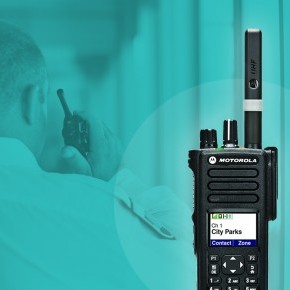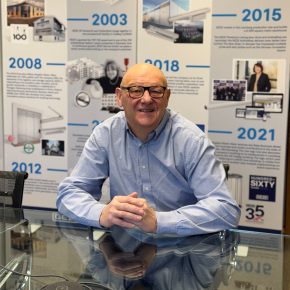
Suring up site safety with two way radio
With more than 2 million working days lost to work-related injuries in UK construction each year, site safety remains a critical challenge for the industry.
And whilst health and safety training and awareness has gone a long way towards promoting safer working practices, that alone cannot solve the problem. In a physically demanding industry where people work with heavy materials and heavy machinery, an accident is always around the corner.
The key for construction firms is communication. How well work teams on a busy site can liaise with each other, how well operatives can spot and share information about risks, and how well supervisors can coordinate work across a whole site are vitally important in recognising and avoiding danger. And, of course, how well teams can respond in the event of an emergency is critical, and potentially life saving.
Two way radio remains the communication tool of choice for most construction firms. With the rise of mobile phones, this surprises some people. But with the latest digital radios providing clearer, more reliable signal than ever, and the expanded functionality offered by linking to smart digital software, the walkie talkie still ticks all the right boxes for keeping busy crews in touch.
Built for industry
One of the key advantages two way radio has over mobile phones is that it is built with industry in mind. Two way radio handsets are designed to be rugged, durable, all weather tools. Most industry class models carry IPC ratings for water, dust and impact resistance, and can take the knocks and bumps you would expect on a construction site.
Two way radios are also built with safety management in mind. Many of the core features nearly all models come with are safety related. So, for example, Lone Worker requires an operative to check in with the network at fixed intervals, otherwise an alarm is raised. Workers operating alone is when a huge number of accidents take place in construction, so this feature is tailor made to provide peace of mind.
Radio handsets are also designed to be easy and straightforward to use. Portable and lightweight, digital models connect easily to bluetooth earpieces for convenient, hands free and wireless use. Push-to-Talk, and even voice activated VOX options, are standard features again intended to make it as easy as possible to make a call to the network – without even having to put your tools down.
And back on the safety theme, push button alarms are standard, so an alert can be raised at the push of a single button, while Man Down will sense an unusual movement such as a fall and activate an alarm automatically. Digital two way radios also feature GPS location tracking, making it easy to quickly pinpoint where an alarm was triggered.
Staying in touch
When it comes to site safety, everyone wants the reassurance of knowing they can always reach help in the event of an emergency. But having a reliable means of communication is also an essential part of accident prevention. If you are trying to coordinate several teams across a large site at once, or you want to warn colleagues about a potential risk, you want to know that your calls will get through.
Two way radio is extremely reliable because it creates a local network. Unlike mobile phones, which rely on a line of sight to the nearest broadcast mast to ensure a good signal, radio handsets act as their own transmitters and receivers, and will communicate flawlessly with other devices within a certain range.
In the past, the extent of that range has been a criticism of two way radio – you might not get coverage over the site of a large development project, for example. Repeater and mobile base station antennas have always been available to boost signal coverage, but in the digital age, two way radio can go even further.
Using what is known as trunking software, you can now link together separate networks over extremely large, or even multiple sites. Not only does this increase coverage area, it allows for very large teams to operate on the same radio network, with channel availability and grouping managed digitally. Radios in Motorola’s MOTOTRBO are an example of products on the market offering this, using the company’s Capacity Plus and Connect Plus software.
Finally, what digital two way radio always guarantees is clear, crisp audio, even in the noisiest environments. As well as digitally sharpened audio, the latest handsets all offer as standard features like noise cancelling, which will eliminate the background noise of heavy machinery, and intelligent audio, which will automatically adjust call volume and EQ on the receiver’s handset.
Find out more
Whatever the size of a construction site, two way radio offers a reliable, durable solution for keeping your workforce in touch and safe. Brentwood Radios has more than 40 years’ experience supplying two way radios to the construction industry. We offer full site surveys and equipment trials before purchase or hire. To find out more, give us a call on 0808 115 2560.
Latest news

21st February 2025
ASSA ABLOY EMEIA: Save valuable time and money with a seamless switch to programmable digital keys
In 2025, access management can be a whole lot easier. By making access part of their digital processes, businesses can put time-consuming key management and the cost of changing the locks firmly behind them. Making this switch is a lot easier than many people think, as ASSA ABLOY explains here…
Posted in Access Control & Door Entry Systems, Architectural Ironmongery, Articles, Building Industry News, Building Products & Structures, Building Services, Doors, Facility Management & Building Services, Health & Safety, Information Technology, Innovations & New Products, Retrofit & Renovation, Security and Fire Protection
21st February 2025
Showersave supports industry leaders in addressing Part L and Part G regulations
Showersave has sponsored and participated in a recent Building Insights LIVE roundtable on ‘Water & Energy Saving Innovations in New Build Housing’.
Posted in Articles, Bathrooms & Toilets, Bathrooms, Bedrooms & Washrooms, Building Associations & Institutes, Building Industry Events, Building Industry News, Building Products & Structures, Building Regulations & Accreditations, Building Services, Exhibitions and Conferences, Interiors, Pipes & Fittings, Plumbing, Retrofit & Renovation, Sustainability & Energy Efficiency
21st February 2025
GEZE: The importance of Specifying High Quality Door Closers on Fire Doors
Andy Howland, Sales & Marketing Director at GEZE UK, discusses why specifying high quality door closers on fire doors is important…
Posted in Access Control & Door Entry Systems, Accessibility, Architectural Ironmongery, Articles, Building Industry News, Building Products & Structures, Building Regulations & Accreditations, Building Services, Doors, Facility Management & Building Services, Health & Safety, Posts, Restoration & Refurbishment, Retrofit & Renovation, Security and Fire Protection
21st February 2025
Insight Data achieves ISO9001 recertification with zero non-conformities
Leading industry data specialist, Insight Data, has successfully achieved the prestigious recertification for ISO9001 with zero non-conformities for the fourth consecutive year.
Posted in Articles, Building Industry News, Building Regulations & Accreditations, Building Services, Information Technology, Research & Materials Testing
 Sign up:
Sign up: